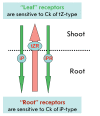Receptor properties and features of cytokinin signaling
- PMID: 23150802
- PMCID: PMC3491891
Receptor properties and features of cytokinin signaling
Abstract
Cytokinins belong to one of the most important and well-known classes of plant hormones. Discovered over half a century ago, cytokinins have retained the attention of researchers due to the variety of the effects they have on the growth and development of vegetable organisms, their participation in a plant adaptation to external conditions, and the potential to be used in biotechnology, agriculture, medicine and even cosmetics. The molecular mechanism by which cytokinins function remained unknown for a long time. Things started to change only in the 21(st)century, after the discovery of the receptors for these phytohormones. It appeared that plants found ways to adapt a two-component signal transduction system borrowed from prokaryotic organisms for cytokinin signalling. This review covers the recent advances in research of the molecular basis for the perception and transduction of the cytokinin signal. Emphasis is placed on cytokinin receptors, their domain and three-dimensional structures, subcellular localization, signalling activity, effect of mutations, ligand-binding properties, and phylogeny.
Keywords: cytokinins; receptors; sensor histidine kinases; signal transduction; two-component systems.
Figures






Similar articles
-
Structural basis for cytokinin receptor signaling: an evolutionary approach.Plant Cell Rep. 2013 Jun;32(6):781-93. doi: 10.1007/s00299-013-1408-3. Epub 2013 Mar 23. Plant Cell Rep. 2013. PMID: 23525743 Review.
-
Advances in upstream players of cytokinin phosphorelay: receptors and histidine phosphotransfer proteins.Plant Cell Rep. 2012 May;31(5):789-99. doi: 10.1007/s00299-012-1229-9. Epub 2012 Feb 15. Plant Cell Rep. 2012. PMID: 22350315 Review.
-
Identification of CRE1 as a cytokinin receptor from Arabidopsis.Nature. 2001 Feb 22;409(6823):1060-3. doi: 10.1038/35059117. Nature. 2001. PMID: 11234017
-
Histidine kinase homologs that act as cytokinin receptors possess overlapping functions in the regulation of shoot and root growth in Arabidopsis.Plant Cell. 2004 Jun;16(6):1365-77. doi: 10.1105/tpc.021477. Epub 2004 May 21. Plant Cell. 2004. PMID: 15155880 Free PMC article.
-
Bacterial assay to study plant sensor histidine kinases.Methods Mol Biol. 2011;779:139-47. doi: 10.1007/978-1-61779-264-9_7. Methods Mol Biol. 2011. PMID: 21837564
Cited by
-
Differential Subcellular Distribution of Cytokinins: How Does Membrane Transport Fit into the Big Picture?Int J Mol Sci. 2021 Mar 26;22(7):3428. doi: 10.3390/ijms22073428. Int J Mol Sci. 2021. PMID: 33810428 Free PMC article. Review.
-
Survey of Genes Involved in Biosynthesis, Transport, and Signaling of Phytohormones with Focus on Solanum lycopersicum.Bioinform Biol Insights. 2016 Sep 26;10:185-207. doi: 10.4137/BBI.S38425. eCollection 2016. Bioinform Biol Insights. 2016. PMID: 27695302 Free PMC article.
-
Changes in cytokinins are sufficient to alter developmental patterns of defense metabolites in Nicotiana attenuata.Plant J. 2017 Jan;89(1):15-30. doi: 10.1111/tpj.13316. Plant J. 2017. PMID: 27557345 Free PMC article.
-
Naturally Occurring and Artificial N9-Cytokinin Conjugates: From Synthesis to Biological Activity and Back.Biomolecules. 2020 May 29;10(6):832. doi: 10.3390/biom10060832. Biomolecules. 2020. PMID: 32485963 Free PMC article. Review.
-
Structural basis for cytokinin receptor signaling: an evolutionary approach.Plant Cell Rep. 2013 Jun;32(6):781-93. doi: 10.1007/s00299-013-1408-3. Epub 2013 Mar 23. Plant Cell Rep. 2013. PMID: 23525743 Review.
References
-
- Miller C.O., Skoog F., von Saltza N.M., Strong F.M.. J. Am. Soc. 1955;77
-
- Mok M.C.. Cytokinins. Chemistry, Activity, and Function. Boca Raton, Ann Arbor, London, Tokyo: CRC Press, 1994:155–166.
-
- Taiz L., Zeiger E.. Plant Physiology, 2010
-
- Romanov G.A.. Russian J. Plant Physiol. 2009;56:268–290.
-
- Romanov G.A.. McGraw Hill Encyclopedia of Science & Technol. 2012;5:205–207.
LinkOut - more resources
Full Text Sources
